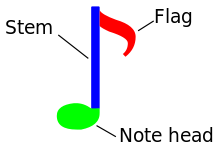Stem (music)


In
second
, the stem runs between the two notes with the higher being placed on the right of the stem and the lower on the left. If the chord contains an odd numbered cluster of notes a second apart (such as C, D, E), the outer two will be on the correct side of the stem, while the middle note will be on the wrong side.
The length of a stem should be that of an octave on the staff,ledger line more than an octave away from the middle line of a staff, the stem will be elongated to touch the middle line. In any polyphonic music in which two parts are written on the same staff, stems are typically shortened to keep the music visually centered upon the staff.

Stems may be altered in various ways to alter the rhythm or other method of performance. For example, a note with diagonal slashes through its stem is played tremolo.
See also
References
- ^ ISBN 978-0-07-294262-0.
